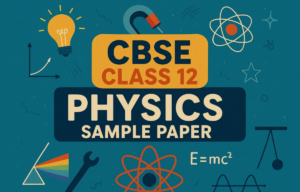Adda247 provides NCERT Solutions for Class 12 Chemistry Chapter 3 Chemical Kinetics. These NCERT Solutions for Class 12 Chemistry Chapter 3 will not only help students boost their board exams and score brilliant marks but also for competitive exams. The Solutions are according to the NCERT guidelines.
The Class 12 Chemistry chapter-wise solutions were provided for the benefit of students. The 12th class sets the base for higher education for every student. This makes it the most crucial class for any student who is aiming for his/her dream of quality education. Scoring good marks in the 12th class is equivalent to quality high education. So, it becomes extremely important for students to give a boost to their class 12 Chemistry preparation with Adda247 NCERT solutions. The students can access the solutions anywhere while browsing the web easily. The solutions are very precise and accurate.
NCERT Solutions for Class 12 Chemistry Chapter 3: Chemical Kinetics
Chemical Kinetics is a branch of chemistry that deals with chemical reaction, their factors, and mechanisms. It is closely related to the chemical reaction and physical process. The principles of chemical kinetics apply to purely physical processes as well as to chemical reactions.
In 1864, Peter Waage and Cato Guldberg pioneered the development of chemical kinetics by formulating the law of mass action, which states that the speed of a chemical reaction is proportional to the quantity of the reacting substance.
The chapter also mentions the factors affecting the rate of a reaction, the integrated rate equation, pseudo-first-order reactions, and the collision theory of chemical kinetics.
NCERT Solutions Class 12 Chemistry Chapter 3 PDF
NCERT Solutions Chapter 3 Chemistry Class 12 plays a vital role in the fundamental development of the concepts of physical chemistry. Without appropriate guidance, it will create a problem for students as their knowledge of concepts can become vague. It will affect your marks in board exams. That’s why a student should refer to the Chemical Kinetics Class 12 NCERT solutions.
Physical Chemistry which is a crucial part of the subject requires thorough reading and understanding of the concepts. Therefore, focusing on qualitative ways of preparation rather than quantitative measures would turn out to be fruitful for an aspiring board examinee.
To solve this problem of preparing from qualitative sources, educational sites like Adda247 provide free solutions in PDF format. Class 12 NCERT Solutions PDF provides an elaborate explanation of the topic. Learn from these PDF files and score a good mark
NCERT Solutions for Class 12 Chemistry Chapter 3 Chemical Kinetics Key Features
- The NCERT Solutions provide clear and precise answers.
- The columns are used wherever necessary.
- We follow the NCERT guidelines.
- These solutions help you to solve and revise the complete syllabus.
- Answers are explained with diagrams and illustrations.
NCERT Solutions for Chemistry Class 12 Chapter 3 Chemical Kinetics Important Questions
Question 1: From the rate expression from the following reaction, determine their order of reaction and the dimension of the rate constants.
- 2NO(g) à N2O(g) Rate = k[NO]2
- H2O2(aq) + 3I–(aq) +2H+ à 2H2O(l) +I3– Rate = k[H2O2][I–]
- CH3CHO(g) à CH4(g) +CO(g) Rate = k[CH3CHO]3/2
- C2H5Cl(g) à C2H4(g) + HCl(g) Rate = k[C2H5C l]
Answer:
- Given rate = k[NO]2
Therefore, the order of the reaction = 2
K = Rate / [NO]2
Dimension of k = molL-1s-1 / (molL-1)2
= molL-1s-1 / mol2L-2
= L mol-1s-1
- Given rate k = [H2O2][I-1]
Therefore order of the reaction = 2
K = Rate / [H2O2][I-1]
Dimension of = mol-1s-1 / (mol/L)(mol/L)
= L-1/mol/s
- Given rate = k[CH3CHO]3/2
Therefore, order of reaction = 3/2
K = Rate/[CH3CH0]3/2
Dimension of = mol-1s-1/mol/L)3/2
= L3/2mol-1/2/s
- Given rate = k[C2H5Cl]
Therefore, order of the reaction = 1k = Rate / [C2H5Cl]
Dimension of = molL-1s-1 / molL-1
= s-1
Question:2 For the reaction:
2A + B à A2B
The rate = k[A][B]2 with k = 2.0 x 10-6 mol-2 L2 / s. Calculate the initial rate of the reaction when [A] = 0.1 mol / L, [B] = 0.2 mol / L. Calculate the rate of reaction after [A] is reduced to 0.06 mol / L.
Answer:
The initial rate of the reactionis
Rate = k [A][B]2
= (2.0 × 10-6 mol-2 L2 s-1) (0.1 mol L-1) (0.2 mol L-1)2
= 8.0 × 10-9 mol2 L2 s-1
When [A] is reduced from 0.1 mol L-1 to 0.06 mol-1, the concentration of A reacted = (0.1 – 0.06) mol-1 L-1 = 0.04 mol L
Therefore, concentration of B reacted= 1/2 x 0.04 mol L-1 = 0.02 mol L-1
Then, concentration of B available, [B] = (0.2 – 0.02) mol L-1
= 0.18 mol L-1
After [A] is reduced to 0.06 mol L-1, the rate of the reaction is given by,
Rate = k [A][B]2
= (2.0 × 10-6 mol-2 L2 s-1) (0.06 mol L-1) (0.18 mol L-1)2
= 3.89 mol L-1 s-1
Question:3 The decomposition of NH3 on platinum surface is zero order reaction. What are rates of production of N2 and H2 if k = 2.5 x 10-4 mol-1 L / s/
Answer:
The decomposition of NH3 is
2NH3 → N2 + 3H2
Rate of reaction,
dx / dt = 1 / 2d[NH3] / dt = d[N2] / dt = 1 / 3d[H2] / dt = k
Where k is the rate constant. Since, reaction is of zero order,
Rate of reaction = dx/dt = d[N2]dt = k
= 2.5 x 10-4 M s-1
But, d[N2] / dt = 1/3d[H2] / dt
: d[H2] / dt = 3 d[N2] / dt
= 3 x 2.5 x 10-4 mol-1L s-1
= 7.5 x 10-4 M s-1
Question:4 The decomposition of dimethyl ether leads to the formation of CH4, H2 and CO and the reaction rate is given by
Rate = k[CH3OCH3]3/2
If the pressure is measured in bar and time in minutes, then what are the units of rate and rate constants?
Answer:
If the pressure is measured in bar and time in minutes, then unit of rate = bar / min
Rate = k(p CH3OCH3)
k = Rate / (p CH3OCH3)3/2
Therefore, unit of rate constants (k) = bar min-1 / bar3/2
= bar-1/2 / min.
Question:5 Mention the factors that affect the rate of a chemical reaction.
Answer:
- Concentration:
On increasing concentration of reactants, the probability of colloisions of molecules increases hence rate of reaction increases.
- Temperature:
On increasing temperature, the kinetic energy of molecules increases, hence, the number of collision increases. Therefore, the rate of reaction also increases.
- Pressure:
On increasing pressure, the molecules of gases come closer to each other. As a result their collisions increase and hence rate of reaction increases.
- Surface Area of Reactants:
On increasing surface area of reactants, the rate of reaction increases. For example, the powdered metals react faster than the metals in a lump.
- Nature of reactants:
If the reactants are ionic in nature than the rate of reaction is faster than those in which reactants are molecular in nature.
Question: 6 A reaction in second order with respect to a reactant. How is the rate of reaction affected if the concentration of the reactant is
- Doubled
- Reduced to half?
Answer:
Let the concentration of the reactant be [A] = a
Rate of reaction, R = k[A]2
= ka2
- If the concentration of the reaction is double i.e., [A] = 2a then the rate of the reaction would be R = k(2a)2 = 4ka2 = 4R
Therefore, the rate of the reaction would increased by 4 times.
- If the concentration of the reactants is reduced to half i.e., [A] = ½ a the rate of the reaction would be
R = k(1/2a)2
= 1/4ka
= 1/4R
Therefore, the rate of the reaction would be reduced to 1/4th .
Question: 7 What is the effect of temperature on the rate constant of a reaction? How can this temperature effect on the rate constant be represented quantitatively?
Answer:
The rate constant is nearly doubled with a rise in temperature by 10° for a chemical reaction.
The temperature effect on the rate constant can be represented quantitatively by Arrhenius equation,
K = Ae-Ea / RT
where, k is the rate constant,
A is the Arrhenius factor or the frequency factor,
R is the gas constant,
T is the temperature, and
Ea is the energy of activation for the reaction
Question:8 In the pseudo first order hydrolysis of ester in water, the following results were obtained:
| t/s | 0 | 30 | 60 | 90 |
| [Ester/mol L-1 | 0.55 | 0.31 | 0.17 | 0.085 |
- Calculate the rate of reaction between the time interval 30 to 60 seconds.
- Calculate the pseudo first-order rate constant for the hydrolysis of ester.
Answer:
- Average rate of reaction between the time interval 30 to 60 seconds = d[Ester] / dt
= 0.31 – 0.17 / 60 – 30
= 0.14 / 30
- For a pseudo first order reaction,
K = 2.303 / t log [R]0 / [R]
For t = 30s, k1 = 2.303 / 30 log 0.55/0.31
= 1.91 x 10-1 / s
For t = 60, k2 = 2.303 / 60 log 0.55 / 0.17
= 1.96 x 10-2 / s
For t = 90, k3 = 2.303 / 90 log 0.55 / 0.085
= 2.07 x 10-2 / s
Then average rate constant, k = k1 = k2 + k3 / 3
1.98 x 10-2 / s
Question: 9 A reaction in first order in A and second order in B.
- Write the different rate equation.
- How is the rate affected on increasing the concentration of B three times?
- How is the rate affected when the concentration of both A and B are doubled?
Answer:
- The different rate equation will be = d[r] / dt = k[A][B]2
- If the concentration of B is increased three times, then –d[R] / dt = k[A][3B]2 = 9.k[A][B]2
Therefore, the rate of reaction will becomes 9 times.
- When the concentration of both A and B are doubled, -d[R] / dt = k[A][B]2
= k[2A][2B]2
= 8k[A][B]2
Therefore, the rate of reaction will increase 8 times.
Question:10 In a reaction between A and B, the initial rate of reaction was measured for different initial concentration of A and B as given below:
| A/ mol / L | 0.20 | 0.20 | 0.40 |
| B/ mol /L | 0.30 | 0.10 | 0.05 |
| r0/ mol /L / s | 5.07 x 10-5 | 5.07 x 10-5 | 1.43 x 10-4 |
What is the order of the reaction with respect to A and B?
Answer:
Let the order of the reaction with respect to A be x and with respect to B be y
Therefore,
ra = k[A]x[B]y
- x 10-5 = k[0.20]x[0.30]y….i
5.07 x 10-5 = k[0.20]x[0.10]y…..ii
1.43 x 10-5 = k[0.40]x[0.05]y…..iii
Dividing equation I by ii, we obtain
5.07 x 10-5 / 5.07 x 10-5 = k[0.20]x[0.30]y / k[0.20]x[0.10]y
= [0.30]y / [0.10]y
= (0.30/0.10)x = (0.30 / 0.10)y
Dividing equation iii. By ii, we obtain
1.43 x 10-5 / 5.07 x 10-5 = k[0.40]x[0.05]y / k[0.20]x[0.10]y
= 2.821 = 2x
Log2.821 = x log2[taking log on both sides]
X = log2.821 / log 2
= 1.496
= 1.5 (approx.)
Hence, the order of the reaction with respect to A is 1.5 and with respect to B is zero.
| NCERT Solutions for Class 12 Chemistry Chapter-wise Free PDF Download |











 HBSE September Result 2025 OUT, Haryana ...
HBSE September Result 2025 OUT, Haryana ...
 CBSE Class 12 Maths Syllabus 2025-26, Do...
CBSE Class 12 Maths Syllabus 2025-26, Do...
 CBSE Class 12 Physics Sample Paper 2025-...
CBSE Class 12 Physics Sample Paper 2025-...






